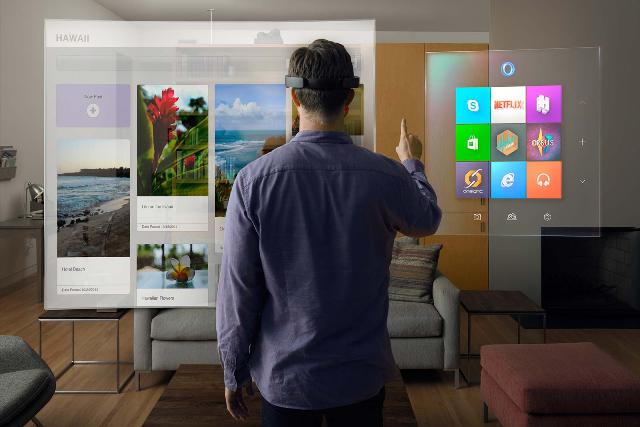|
Finally. After all this time speculating about the boring, antiquated Oculus Rift headset, Microsoft this week demoed a new product that promises an actual step forward in melding virtual-reality computing into everyday living. CNET’s report says: “Microsoft wants us to imagine a world without screens, where information merely floats in front of you.” This, folks — this is the Kool-Aid I’m chugging. I’ve been pushing back (futile, I know) against Oculus Rift during the last year of slobbering hype because it’s a stale idea already proven not to be the kind of interface that’s useful to anyone beyond gamers. Goggles ’n’ gloves — so 1990s. The future (if I may structure a sentence like this without cringing) is devices that knit cyberspace back into physical space — with our eyes open. Oculus Rift and its requisite knock-offs blind us from the world, forcing us to interface with virtual worlds and only virtual worlds, and in the dark to boot; they require users to exit the physical and climb inside the digital box. They operate under an outmoded idea that cyberspace is its own domain somehow separate from “real” space. The ultimate metaphor of "The Matrix" should be the guiding hand of tech developers. Why plug something digital into your head and lie there like a corpse when you can move through the world and still see the digital all around you? Microsoft’s new project reveals a fresher, more realistic perspective. The HoloLens is a wearable set of glasses that projects 3D images in front of the user, images that can be interacted with physically. It’s augmented reality, a blending of the digital into the physical, a sprinkling of bits among the atoms. It has the potential to be a thousand times more useful.
In fact, it could succeed where Google Glass ultimately failed. HoloLens allows for tasks, for work; that’s something Glass never showed much of. What could you do with Glass, other than record video of everything and everyone in front of you? (Now that Glass is apparently dead or at least on life support, the eulogies abound. The Atlantic has the wisest hindsight, claiming that the much-debated camera actually killed the thing.) HoloLens seems to allow for design, visualization and, importantly, collaboration. The device is untethered, so it operates independently of a PC connection; it’s got its own CPU, GPU and, hey, an HPU (holographic processing unit). It looks lighter and more freely functional than closed-system VR units. But, crucially, the lenses are see-through, so the user remains in his or her actual environment rather than sealing themselves off in their own heads. The importance of this for new-user point-of-entry can’t be overstated. My mom would freak out if I put an Oculus Rift on her head, but she’d comfortably chuckle her way through a HoloLens experience. All this is based on the new Windows 10 platform. A lifelong Mac user, this doesn’t thrill me. But while Apple concentrates on making watches — talk about obsolete tech — I’ll follow this project however I’m capable. “We’re not talking about putting you into virtual worlds,” says HoloLens leader Alex Kipman, same guy behind the Kinect camera. “We’re dreaming beyond virtual worlds, beyond screens, beyond pixels.” Beyond screens. Amen, sir.
0 Comments
Leave a Reply. |
this blahg
I'm THOMAS CONNER, Ph.D. in Communication & STS, and a longtime culture journalist. Categories
All
Archives
June 2024
|


 RSS Feed
RSS Feed